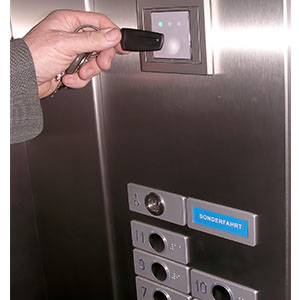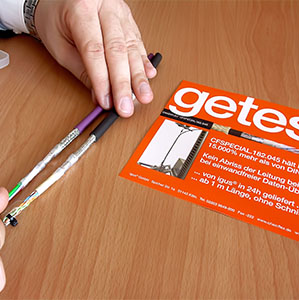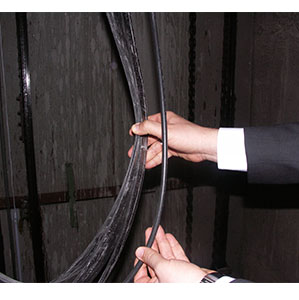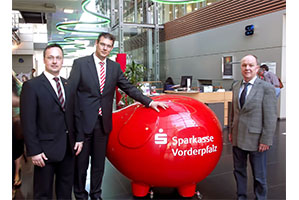Do not enter
Special bus cable for chip card readers in a lift system
A group of lifts installed in a savings bank building serves eleven floors and the basement area. Customers are not permitted to access all levels. This is enforced by an access control system. The bus signals required for this purpose are transmitted via a special cable with a structure proven to withstand the high push-pull forces associated with the freely suspended application.
"In 2011, we replaced a purely mechanical lift system in use at our location in Ludwigshafen," reports Michael Krauss, Head of Construction Organisation at the Sparkasse Vorderpfalz. "It involves two passenger lifts with a rated load capacity of 650 kg and one freight lift with a rated load capacity of 1.1 t. The special feature is that the three lifts share a single shaft. The lifts serve all levels of the building. The system is controlled to ensure that only employees have access to some of the floors. If necessary, access to other floors can be blocked at any time of day for any length of time. The corresponding data are stored online by the lift engineering contractor. All it takes is a phone call. “
The requirements profile from the bank was clear from the onset. The existing access control system for employees was to be transferred to the lifts so that existing chip cards could be used to access the bank and operate the lifts. However, implementing the technical side proved a bit more challenging than first thought. The lift contractor was not able to offer a bus cable capable of being connected to the existing card readers. The solution came from Keipp, the bank's electrical contractor of choice in Ludwigshafen.

They extended the access control system to the lift system. The existing card readers were connected via a special chainflex cable.
"Our contact person recommended that we use an extremely robust bus cable for long, hanging travel paths from the world of industry," recalls Krauss. "However, back then it was still in the testing phase. We decided to go ahead and use it anyway. We've never regretted that decision. “

The bus cable (purple jacket) would quickly break due to its own weight. The special cable with the reinforced black jacket, designed for hanging applications, absorbs the high forces.
Technical advantages of the special cable
The lift system features a special chainflex cable CFSPECIAL182.045 for hanging applications made by Cologne, Germany-based igus GmbH, which exceeds the requirements of all applicable standards and guidelines and far outperforms them in terms of tensile strength. The CFSPECIAL series introduced in 2012 expands the standard product range by adding cables for highly demanding tasks. This series also includes special cables, such as for the rail industry, and cables with high tensile strength.
The special cables offer a wide array of benefits. They provide solutions for applications that go beyond normal energy chain applications. The growing product range of special cables is geared towards the requirements of customers from all industries, for which specific solutions are developed and tested.
"We fabricate corresponding cables for virtually any application area, while making use of an extremely wide variety of materials and processes," explains igus Product Manager Andreas Muckes. "Depending on the design, this is possible even for lengths of 500 metres." In our in-house lab, the different cables are tested, primarily for their dynamics over long and short paths. Radii and torsion are important aspects here. The task is always to find the right cable concept for demanding motions. As a result, over 2 billion test cycles are run each year as part of research and development.
Bulletproof special cable
The special cable for data transmission in the lift system is suspended freely in the shaft and easily absorbs the weight forces that occur. It has the same four-pair wire design as a normal Ethernet cable and has a TPE inner jacket and a braided shield with extreme bending strength. The difference between these cables and standard bus cables is in their jacket construction. The black outer jacket consists of a low-adhesion PUR compound with an embedded Kevlar aramid fibre. "The material is similar to that of a bulletproof vest," explains Muckes. Although the technical structure sounds simple, it is very complex. The special fibre is braided over a thin jacket. The jacket embeds itself into the material during subsequent manufacturing of the outer jacket and absorbs all of the external forces that occur.
Laboratory tests have shown that, in the tensile test, the special cable performs about 15,000 percent above the standard required in the corresponding DIN VDE 0298. Tightened at a torque of 2,919 N, the cable does not break and the data transmission remains in place for the long term. The cable length in the system is 74 meters.

The special cable is freely suspended in the lift shaft. It is reliable and works any problems.
Normal bus cables cannot be used due to their inherent weight. Their lack of a carrying member means that they can only take loads up to 15 N/mm². Taken together, all these facts mean that the freely suspended cable could be over 1 kilometre long before having to contend with any decrease in performance. "For us, this means that we could theoretically increase the height of the building significantly," states the construction organisation manager. Initially, an additional cable was installed in the lift system to provide an added safety margin to be on the safe side and to make it possible to measure the data records that were generated. The lift systems are used very frequently. Just under six months after the system was commissioned, it had already made some 56,970 trips. After two years, they will have easily surpassed a figure of 160,000 without any hint of a malfunction. "The system is certainly not going to reach the maximum number of trips for which it is certified. A new lift control system will be installed first well before that," says igus sales advisor Eugen Kowalczyk with confidence. This is because chainflex cables for industrial applications are designed for very small bending radii, high numbers of cycles, speeds, accelerations and demanding environmental conditions.
Error-free data transmission
This particularly durable special cable with aramid fibre was originally developed for storage and retrieval machines used in high-rack facilities with racks up to 100 metres high. At this height, data transmission problems may occur with standard cables. The chainflex cables also demonstrate their performance capacity in movable camera systems in forklift applications where a camera is integrated into the fork arm and the cable is wound around drums. All these applications have in common that data transmission must occur error-free and safety is of great importance. Moreover, the processes must never come to a stop. "The lift just has to work. In order to ensure smooth customer traffic, it cannot stop unexpectedly," says the Director of Facility Management at Sparkasse.

From left to right: Michael Krauß (Sparkasse Vorderpfalz), Andreas Muckes and Eugen Kowalczyk (both igus GmbH)
Even though this cable is a special solution, developed for the highest demands, all of the experience is channeled into the various standard chainflex products. This way, the customer is always on the safe side and receives the right cable for any requirement.